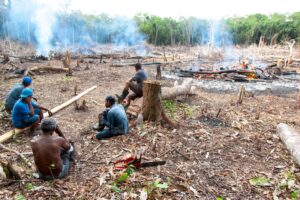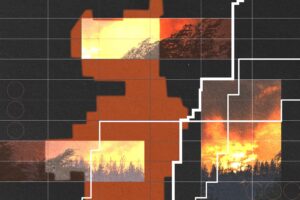Welcome to Carbon Brief’s China Briefing.
China Briefing handpicks and explains the most important climate and energy stories from China over the past fortnight. Subscribe for free here.
Key developments
Critical mineral ‘deal’
TRANSITION TURMOIL: US president Donald Trump said China and the US reached a “deal” after talks were held in London, reported the BBC News, adding that “he said China had agreed to supply US companies with magnets and rare earth metals”. Shortly after the announcement, a Chinese manufacturer confirmed that it received “export permits” to countries including the US, according to Bloomberg. China’s earlier move to impose export curbs on critical minerals had “hit” the global auto industry, said Reuters. In answering Carbon Brief’s question of how the recent mineral disputes may affect global energy transition, Tian Jietang, director-general of the research department of industrial economy at the Development Research Center of the State Council said that the minerals are a “very important factor” for “new energy” development, but the “reason” behind the turmoil is “not from China”. China is “always open” to cooperate with the world for “faster green transition”, he added at an Asia House event.

‘FIRM’ CLIMATE ‘ACTIVIST’: Tian emphasised that China has always been a staunch contributor to global “green transition”. A similar line appeared in a comment article in the Communist party-affiliated newspaper People’s Daily, which called China a “firm activist and important contributor to the world’s green development”. In another People’s Daily article, the newspaper explained that the “direct reason” behind China’s “insist[ence] on carbon reduction” is that “climate warming threatens human survival and the continuation of civilisation”. It added that such “green and low-carbon transition” is also good for China’s economy and society. China Daily said the US’s tariffs on “clean energy products”, on the contrary, are “negatively affecting both [the] US and global green energy”.
Renewable pricing shift
MARKET PRICE: China entered a ”new stage of market-based pricing” for renewables on 1 June, after a notification was issued earlier this year, reported local newspaper Beijing Daily. The newspaper said projects that started operating before June would be paid prices pegged to the local coal-fired electricity price, in line with the previous policy, whereas electricity prices from projects operating after June will not be “protected”. (See the Carbon Brief explainer on the new policy.) The Shanghai-based Paper said there had been a rush to complete renewable projects before the June deadline – new installations of solar in April alone soared by 215%. As of April, the total capacity of wind and solar reached 1,530 gigawatts (GW) in China, “surpassing” the capacity of thermal power, reported industry news outlet BJX News. However, some wind and solar projects have been halted as a result of the new policy, said financial publication Yicai. The outlet quoted an unnamed source saying the returns for some projects are “no longer economically feasible”.
-
Sign up to Carbon Brief’s free “China Briefing” email newsletter. All you need to know about the latest developments relating to China and climate change. Sent to your inbox every Thursday.
‘NEW ELECTRICITY SYSTEM’: Meanwhile, the plans to construct the “first batch of pilot projects” for a “new electricity system” was announced, reported BJX News. It added that according to a notification from the National Energy Administration (NEA), the pilot projects will focus on seven areas, including building “smart microgrids” and “virtual power plants”, better connecting clean energy “bases” to the rest of the country and developing “next-generation coal power”. Quoting experts, China Energy Net said that the success in building such a new system lies in transferring the current system from a “single” network to an “‘adaptability-early warning’ planning paradigm” over the next 15th “five-year plan” period (2026-30). The new system should be dominated by renewable energy and respond to risks, such as extreme weather, added the outlet. The NEA confirmed that “speeding up” plans for renewable energy over the next five-year plan period is one of its work priorities for the second half of the year, according to BJX News.
More plans issued as industry and oil set to drop
NEW SYSTEMS: China is aiming to build a “national standardised system for responding to climate change”, covering mitigation and adaptation, reported state news agency Xinhua. In an official Q&A, the Ministry of Ecology and Environment (MEE) said that it led the drafting of the new system, issued jointly with 14 other departments. Separately, the Central Committee of the Communist party of China and the State Council said that China’s market-based approach to environmental issues, such as carbon dioxide (CO2) emissions trading, should be “basically complete” by 2027, reported BJX News. This will include stronger links between the national emissions trading system (ETS) and related markets for “CCERs” and “GECs”, the outlet said. (The steel, cement and aluminium industries are being consulted over joining China’s national emissions trading system, ETS, according to a screenshot of a policy document circulating on social media. The document is not public, but its existence has been confirmed to Carbon Brief by multiple sources.)
INDUSTRY EMISSIONS: Meanwhile, the “national standards for product carbon footprints” for nine products, including electrolytic aluminium, chemical fibres and plastic, have been established, said the People’s Daily. It is estimated that the total carbon dioxide (CO2) emissions from the industry sector could drop to 450m tonnes in 2060, down 95% from 2025, according to a joint report by the Tsinghua University, as well as Energy Foundation China and the Chinese Academy of Environmental Planning – a research institute under the MEE, reported China Science Daily.
FALLING OIL DEMAND: The overall demand for oil is set to decline in China, with the “faster adoption” of “new-energy vehicles” (NEVs) offsetting growth in other areas, reported state-run newspaper China Daily. The outlet added that NEVs and liquefied natural gas (LNG) heavy trucks played a “significant role” in reducing demand for “traditional fuels” in 2024. In addition, strong sales of electric trucks – boosted by government incentives – pushed down demand for diesel, which makes up over a quarter of Chinese oil demand, said Bloomberg. Another article by China Daily said that one incentive – the equipment trade-in policy – motivated more than 4m car trade-in applications between January and May 2025. It said more than half of applications in the first four months of the year were for NEVs. The total production and sales of NEV reached just under 6m units in the first five months of this year, a year-on-year increase of around 45%, reported Xinhua.
Extreme weather events
RAIN AND HEATWAVES: Yunnan province in southeast China was hit by “flash floods and mudslides” triggered by heavy rainfall, affecting around 5,000 residents, reported Reuters. Hunan province in the south also received pouring rain, which “seriously damaged” roads and power facilities, said state broadcaster CCTV. Heatwaves, in the meantime, swept northern China with temperatures in Hebei and Xinjiang province topping 40C, reported China National Emergency Broadcasting Center, a state-run media outlet. People’s Daily reported that the central government had allocated 45m yuan ($6.2m) of “natural disaster relief funds” to support flood control and disaster relief in Yunnan, a landslide in Tibet, and drought relief in Gansu and Ningxia.
11,000,000,000
The capacity of newly approved coal power plants in the first quarter of 2025 in watts – some 11 gigawatts (GW). This is 1GW more than the first six months of last year, according to a report from NGO Greenpeace, covered by Reuters. The newswire added that China had approved 289GW of new coal capacity over 2021-25 and that last year saw the first annual decline in approvals since 2021.
Spotlight
More than 100bn yuan poured into coal via ‘capacity payments’ in 2024
To date, there is no clear evidence that China’s coal “capacity payments” are helping coal-fired power plants to transfer into a “supporting role” with reduced output and emissions, according to a Carbon Brief guest post by Mingxin Zhang, coal researcher at Global Energy Monitor (GEM).
In the first year of the scheme, GEM finds that some 70-100% of China’s coal plants received payments totalling more than 100bn yuan ($14.8bn), boosting their revenues by around 5-8%.
In this issue, Carbon Brief highlights the key findings of the guest post. The full article is available on Carbon Brief’s website.
A ‘supporting’ role for coal
China rolled out a system of “capacity payments” in January 2024, with the aim of maintaining energy security while helping coal-fired power plants shift into a “supporting role”, alongside a growing share of variable renewables.
The mechanism essentially provides a monthly “standby” payment to eligible public coal plants, to help cover fixed operating costs during low production periods and to ensure that they are available to switch on during peak demand periods.
The national framework sets payment levels at either 30% or 50% of a benchmark coal plant’s total fixed costs, which was determined to be 330 yuan ($45.8) per kilowatt (kW).
To illustrate the mechanism’s impact, consider a 600 megawatt (MW) coal plant running at China’s 2024 average rates – operating for 4,628 hours a year and selling electricity at 0.452 yuan ($0.063) per kilowatt-hour (kWh).
If it receives a 30% capacity payment, roughly 59.4m yuan ($8.2m) would be added to its bank account, driving up the revenue by 4.7%. If the rate is at the 50% level, the bump rises to 7.9%.
Project year one
After one year of China’s programme, GEM’s analysis finds that, while the policy has contributed to coal power plant revenue, there is still little definitive evidence to show that it is helping coal plants reduce their operation, as intended.
Only 12 provincial governments – representing 38% of the country’s total operating coal capacity – have released lists of qualifying plants.
Based on the national policy’s payment levels and the 12 provincial recipient lists, the capacity payments in these provinces alone was more than 40bn yuan ($5.5bn).
Combining the total operating capacity and payment numbers from the 12 provinces that have published data with GEM’s most recent national capacity figures, the analysis estimates that the total national payout in 2024 was approximately 107bn yuan ($14.8bn).
(This figure is uncertain. Greater transparency would help clarify how the mechanism is functioning and its role in shaping the future of coal in China’s power system.)
Despite restrictions, most coal capacity is eligible
By cross-referencing provincial recipient lists with GEM’s Global Coal Plant Tracker (GCPT), it is possible to estimate the share of each province’s coal capacity receiving payments.
In almost all of the 12 provinces that published recipient lists, 70-100% of coal capacity is eligible for payments.
The programme said that only “compliant, public operating coal units” are eligible for the capacity payments and excluded three categories:
- “Captive” units, which exclusively serve specific industrial or commercial entities and operate independently from the public power grid;
- Units failing to meet energy efficiency, environmental performance, or operational flexibility standards;
- Units not compliant with the broader “national plan”, a criterion that is not further clarified in the guidelines.
In some cases, the scheme as implemented by individual provinces appears inconsistent with the eligibility criteria. For example, the Mancheng Mill power station in Hebei provides heat and power exclusively to a pulp and paper industrial park. This appears inconsistent with the “captive unit” exclusion.
Some newly built coal power plants and decades-old plants were also included. For example, Beihai Bebuwan power station Unit 4 in Guangxi began operating in March 2024 and was added to the recipient list in September 2024. Shenhua Panshan power station Units 1 and 2 in Tianjin began operating in 1994 and were retrofitted in 2023.
Finally, several provincial lists include smaller units, which may have limited ability to contribute to peak demand management. For example, five 57MW units from Shaoxing Binhai power station in Zhejiang were accredited for capacity payments.
Their actual contribution to evening peak load, when generation from solar and wind is low, is unclear from the list or other available provincial assessments.
More questions than answers?
There was only two months between the announcement of coal capacity payments and their implementation, leaving no time for pilot programmes or detailed feedback. This may help explain the ambiguities that have emerged during the provincial execution process.
Our analysis of the first year of the scheme suggests that provincial discretion has played a major role, with national criteria loosely applied in practice.
Moreover, there is no clear evidence to date that the mechanism has led to reduced coal utilisation hours, or significantly increased solar and wind generation.
Watch, read, listen
MINISTER’S COMMENT: Huang Runqiu, head of China’s MEE, penned an article about biodiversity for Qiushi, the Communist party’s leading magazine on ideology.
US NUCLEAR COMPONENT BAN: The Hong Kong-based South China Morning Post published an analysis on China’s nuclear energy against the background of the US’s nuclear power controls.
CARON NEUTRALITY FORUM: A group of prominent Chinese scholars gathered in Shanghai and made speeches about China’s “dual-carbon goals”, according to the official WeChat account of the Research Institute of Carbon Neutrality of the Shanghai Jiao Tong University.
EV CCOMPETITION: BBC News international business correspondent Theo Leggett recorded a reading of his analysis of the expansion of Chinese cheap electric vehicles (EVs), as well as security concerns over them.
New science
Embracing the future, powering growth: An energy system renewed for China
Springer Nature
A book jointly written by oil major Shell and the Development Research Center of the State Council of China explored energy transition challenges and pathways in China. At the book’s launch event, attended by Carbon Brief, representatives from both organisations introduced the main arguments in the book, including challenges China faces in reaching its “dual-carbon” goals, its high reliance on coal and regional disparities between renewable energy resources and demands, as well as its commitment to reach carbon neutrality in just 30 years – a shorter timeline than most developed countries. The book outlines three “approaches” and five “supports”, including electrification, better carbon and electricity pricing, legal support and investing in energy storage, as well as other resources, such as hydrogen and nuclear.
A machine learning approach to carbon emissions prediction of the top eleven emitters by 2030 and their prospects for meeting Paris Agreement targets
Scientific Reports
China, India, Japan, Canada, South Korea and Indonesia are projected to miss their 2030 emissions reduction targets by “significant margins”, according to new research. The authors used a machine learning approach to analyse data from 1990-2023 from the 11 highest emitting countries. They found that Russia is on track to exceed its reduction targets, while Germany and the US will “fall slightly short”. Iran and Saudi Arabia are expected to increase emissions rather than reduce them, according to the study. The authors say that “emerging economies require international collaboration and investment to support low-carbon transitions”.
Follow Carbon Brief on WeChat
Scan the QR code to follow Carbon Brief’s Chinese-translated articles
Recently published:
China Briefing is compiled by Wanyuan Song and Anika Patel. It is edited by Wanyuan Song and Dr Simon Evans. Please send tips and feedback to china@carbonbrief.org
The post China Briefing 12 June 2025: Critical mineral exports; Electricity price; Coal ‘capacity payment’ appeared first on Carbon Brief.
China Briefing 12 June 2025: Critical mineral exports; Electricity price; Coal ‘capacity payment’
Climate Change
UN report: Five charts showing how global deforestation is declining
The amount of forest lost around the world has reduced by millions of hectares each year in recent decades, but countries are still off track to meet “important” deforestation targets.
These are the findings of the Global Forest Resources Assessment – a major new report from the UN’s Food and Agriculture Organization – which says that an estimated 10.9m hectares (Mha) of land was deforested each year between 2015 and 2025.
This is almost 7Mha less than the amount of annual forest loss over 1990-2000.
Since 1990, the area of forest destroyed each year has halved in South America, although it still remains the region with the highest amount of deforestation.
Europe was the only region in the world where annual forest loss has increased since 1990.
Agriculture has historically been the leading cause of deforestation around the world, but the report notes that wildfires, climate change-fuelled extreme weather, insects and diseases increasingly pose a threat.
The Global Forest Resources Assessment is published every five years. The 2025 report compiles and analyses national forest data from almost every country in the world over 1990-2025.
Carbon Brief has picked out five key findings from the report around deforestation, carbon storage and the amount of forest held within protected areas around the world.
1. Rates of deforestation are declining around the world

Rates of annual deforestation, in thousands of hectares, in South America, Asia, Africa, North and Central America, Oceania and Europe over 1990-2000 (dark blue), 2000-15 (medium blue) and 2015-25 (light blue). Source: Global Forest Resources Assessment 2025
In total, around 489Mha of forest have been lost due to deforestation since 1990, the new report finds. Most of this – 88% – occurred in the tropics.
This breaks down to around 10.9Mha of forest lost each year between 2015 and 2025, a reduction compared to 13.6Mha of loss over 2000-15 and 17.6Mha over 1990-2000.
Deforestation refers to the clearing of a forest, typically to repurpose the land for agriculture or use the trees for wood.
The chart above shows that South America experiences the most forest loss each year, although annual deforestation levels have halved from 8.2Mha over 1990-2000 to 4.2Mha over 2015-25.
Annual deforestation in Asia also saw a sizable reduction, from 3.9Mha over 1990-2000 to 2Mha over 2015-25, the report says.
Europe had the lowest overall deforestation rates, but was also the only region to record an increase over the last 35 years, with deforestation rates growing from 126,000 hectares over 1990-2000 to 145,000 hectares in the past 10 years.
Despite the downward global trend, FAO chief Dr Qu Dongyu notes in the report’s foreword that the “world is not on track to meet important global forest targets”.
In 2021, more than 100 countries pledged to halt and reverse global deforestation by 2030. But deforestation rates in 2024 were 63% higher than the trajectory needed to meet this 2030 target, according to a recent report from civil society groups.
The goals of this pledge were formally recognised in a key text at the COP28 climate summit in Dubai in 2023, which “emphasise[d]” that halting and reversing deforestation and forest degradation by 2030 would be key to meeting climate goals.
2. Global net forest loss has more than halved since 1990

Forest area net change by country between 1990 and 2025, in hectares. Source: Global Forest Resources Assessment 2025
The new report finds that forests cover more than 4bn hectares of land, an area encompassing one-third of the planet’s land surface.
More than half of the world’s forested area is located in just five countries: Russia, Brazil, Canada, the US and China.
The map above shows that, overall, more forest is lost than gained each year around the world. There was 6.8Mha of forest growth over 2015-25, but 10.9Mha of forest lost.
The annual rate of this global net forest loss – the amount that deforestation has exceeded the amount regrown – has more than halved since 1990, dropping from 10.7Mha over 1990-2000 to 4.1Mha over 2015-25.
The report says this change was due to reduced deforestation in some countries and increased forest expansion in others. However, the rate of forest expansion has also slowed over time – from 9.9Mha per year in 2000-15 to 6.8Mha per year in 2015-25.
There are many driving factors behind continuing deforestation. Agriculture has historically been the leading cause of forest loss, but wildfire is increasingly posing a threat. Wildfires were the leading driver of tropical forest loss in 2024 for the first time on record, a Global Forest Watch report found earlier this year.
The new UN report says that an average of 261Mha of land was burned by fire each year over 2007-19. Around half of this area was forest. Around 80% of the forested land impacted by fires in 2019 was in the subtropics – areas located just outside tropical regions, such as parts of Argentina, the US and Australia.
The report notes that fire is widely used in land management practices, but uncontrolled fires can have “major negative impacts on people, ecosystems and climate”.
It adds that researchers gathered information on fires up as far as 2023, but chose to focus on 2007-19 due to a lack of more recent data for some countries.
A different report from an international team of scientists recently found that fires burned at least 370Mha of land – an area larger than India – between March 2024 and February 2025.
3. Many countries are hugely increasing their forest area
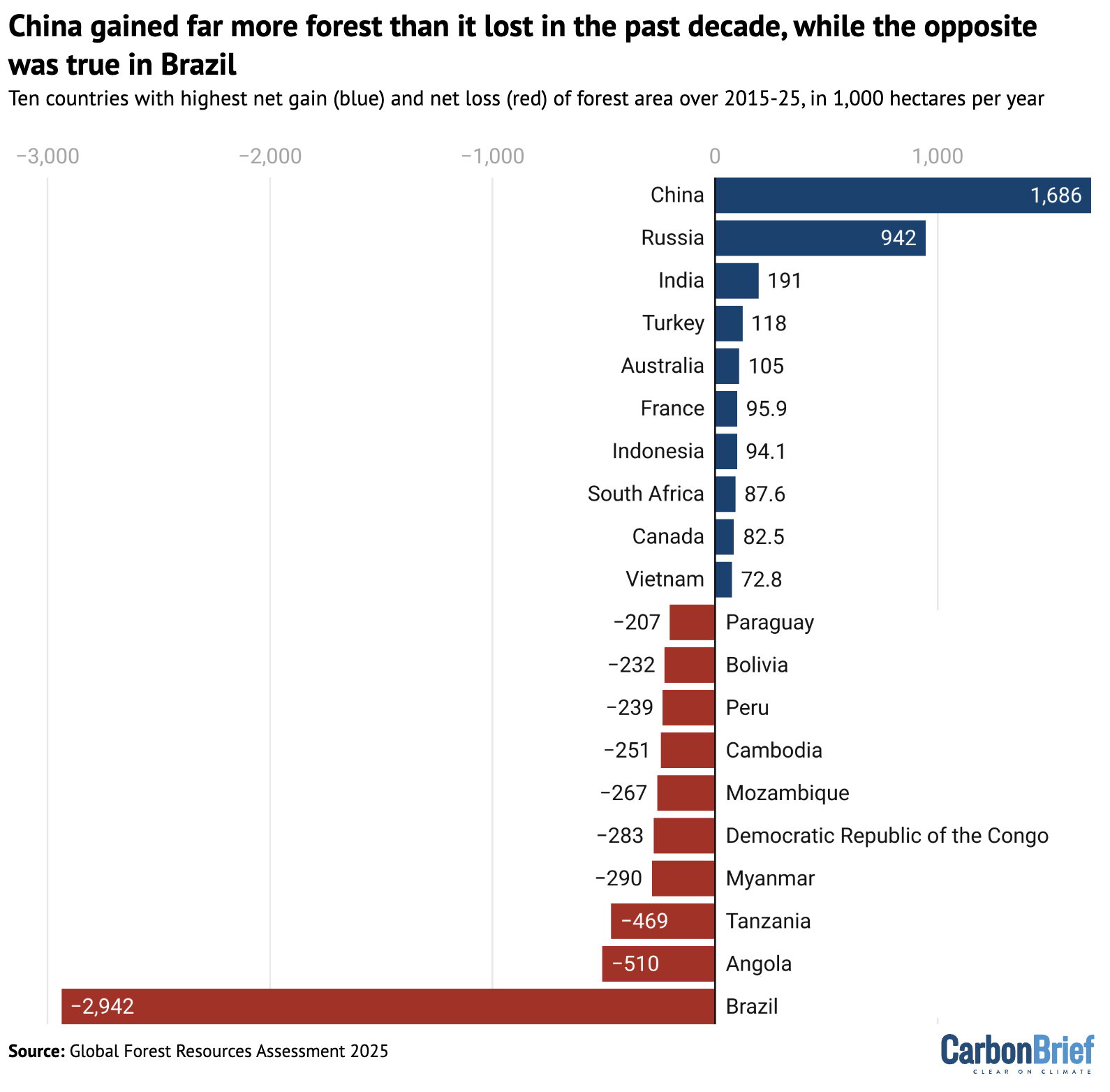
Top 10 countries for annual net gain (blue) and net loss (red) of forest area over 2015-25, in 1,000 hectares per year. Source: Global Forest Resources Assessment 2025
Globally, deforestation is declining, but the trend varies from country to country.
The chart above shows that some nations, such as China and Russia, added a lot more forest cover than they removed in the past decade through, for example, afforestation programmes.
But in other countries – particularly Brazil – the level of deforestation far surpasses the amount of forest re-grown.
Deforestation in Brazil dropped by almost one-third between 2023 and 2024, news outlet Brasil de Fato reported earlier this year, which was during the time Luiz Inácio Lula da Silva took over as president. The new UN report finds that, on average, Brazil lost 2.9Mha of forest area each year over 2015-25, compared to 5.8Mha over 1990-2000.
Russia’s net gain of forest cover increased significantly since 1990 – growing from 80,400ha per year in 1990-2000 to 942,000ha per year in 2015-25.
In China, although it is also planting significant levels of forest, the forest level gained has dropped over time, from 2.2Mha per year in 2000-15 to 1.7Mha per year in 2015-25.
Levels of net forest gain in Canada also fell from 513,000ha per year in 2000-15 to 82,500ha per year in 2015-25.
In the US, the net forest growth trend reversed over the past decade – from 437,000ha per year of gain in 2000-15 to a net forest loss of 120,000ha per year from 2015 to 2025.
Oceania reversed a previously negative trend to gain 140,000ha of forests per year in the past decade, the report says. This was mainly due to changes in Australia, where previous losses of tens of thousands of hectares each year turned into an annual net gain of 105,000ha each year by 2015-25.
4. The world’s forests hold more than 700bn tonnes of carbon
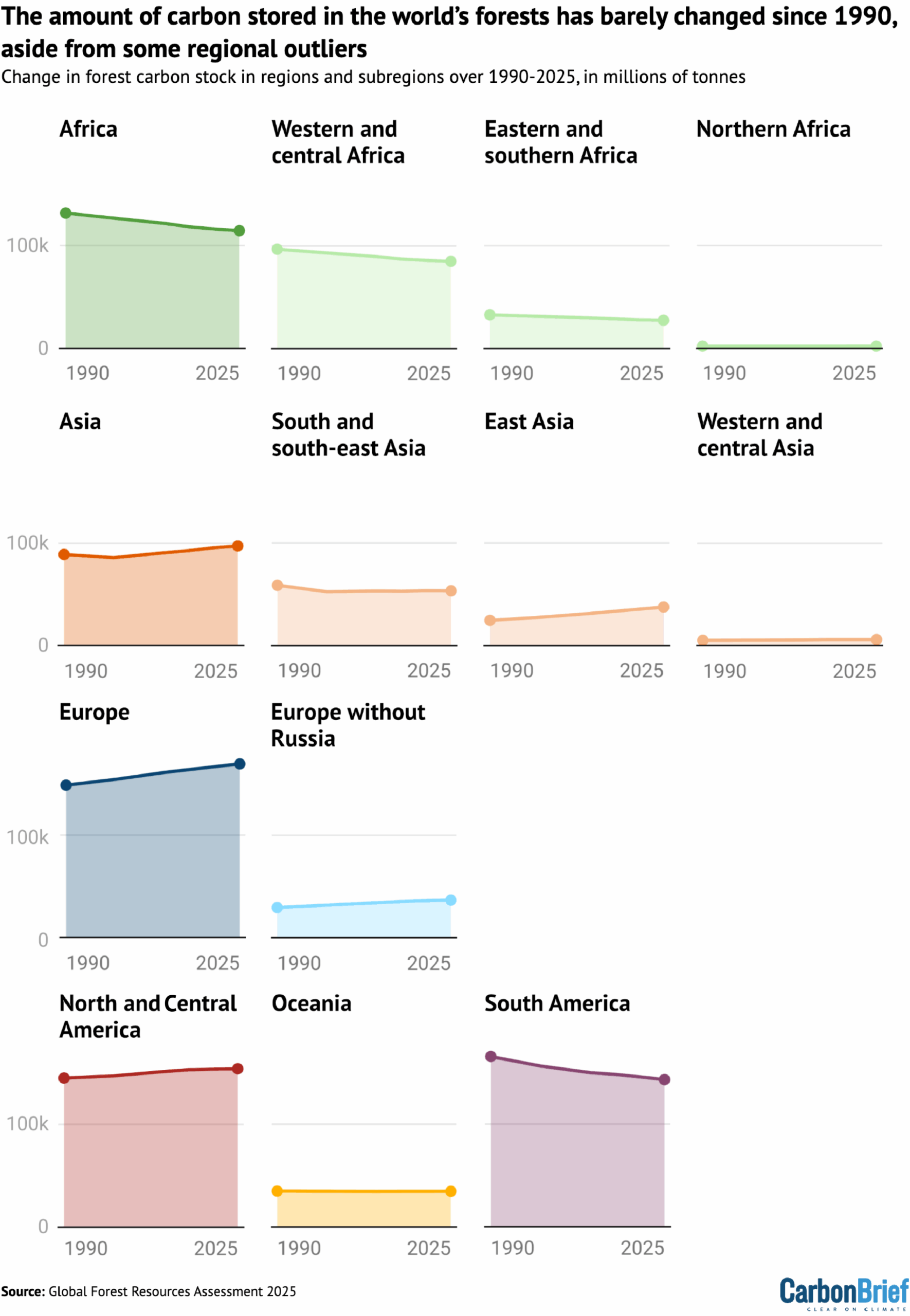
Changes in forest carbon stock by region and subregion of the world over 1990-2025. Source: Global Forest Resources Assessment 2025
The “carbon stock” of a forest refers to how much carbon is stored in its trees and soils. Forests are among the planet’s major carbon sinks.
The new report estimates that forests stored an estimated 714bn tonnes, or gigatonnes, of carbon (GtC) in 2025.
Europe (including Russia) and the Americas account for two-thirds of the world’s total forest carbon storage.
The global forest carbon stock decreased from 716GtC to 706GtC between 1990 and 2000, before growing slightly again by 2025. The report mainly attributes this recent increase to forest growth in Asia and Europe.
The report notes that the total amount of carbon stored in forests has remained largely static over the past 35 years, but with some regional differences, as highlighted in the chart above.
The amount of carbon stored in forests across east Asia, Europe and North America is “significantly higher” now due to expanded forest areas, but it is lower in South America, Africa and Central America.
Several studies have shown that there are limitations on the ability of forests to keep absorbing CO2, with difficulties posed by hotter, drier weather fuelled by climate change.
A 2024 study found that record heat in 2023 negatively impacted the ability of land and ocean sinks to absorb carbon – and that the global land sink was at its weakest since 2003.
Another study, published in 2022, said that drying and warming as a result of deforestation reduces the carbon storage ability of tropical forests, especially in the Congo basin and the Amazon rainforest.
5. Around one-fifth of the world’s forests are located in protected areas
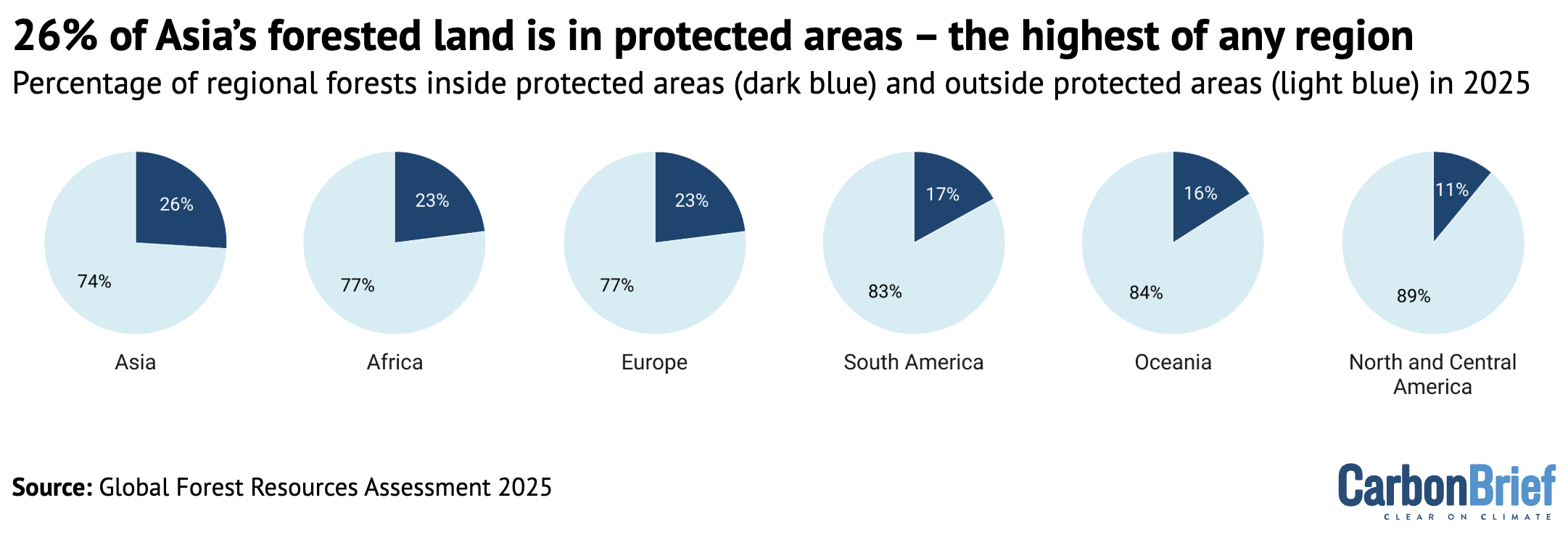
The percentage of forest land in Asia, Africa, Europe, South America, Oceania and North and Central America contained inside protected areas (dark blue) and outside protected areas (light blue) in 2025. Source: Global Forest Resources Assessment 2025
The amount of forested land located in protected areas increased across all regions between 1990 and 2025.
For an area to be considered “protected”, it must be managed in a way that conserves nature.
Around 20% of the world’s forests are located in these protected areas, the new report finds, which amounts to 813Mha of land – an area almost the size of Brazil.
Nearly every country in the world has pledged to protect 30% of the Earth’s land and sea by 2030. However, more than half of countries have not committed to this target on a national basis, Carbon Brief analysis showed earlier this year.
Almost 18% of land and around 8% of the ocean are currently in protected areas, a UN report found last year. The level is increasing, the report said, but considerable progress is still needed to reach the 2030 goal.
The new UN report notes that Europe, including Russia, holds 235Mha of protected forest area, which is the largest of any region and accounts for 23% of the continent’s total forested land.
As highlighted in the chart above, 26% of all forests in Asia are protected, which is the highest of any region. The report notes that this is largely due to a vast amount of protected forested land in Indonesia.
Three countries and one island territory reported that upwards of 90% of their forests are protected – Norfolk Island, Saudi Arabia, Cook Islands and Uzbekistan.
The post UN report: Five charts showing how global deforestation is declining appeared first on Carbon Brief.
UN report: Five charts showing how global deforestation is declining
Climate Change
Federal Appeals Court Pauses Litigation Over Florida’s Alligator Alcatraz
The Trump administration had sought the stay of proceedings in the case, arguing its attorneys were furloughed during the government shutdown. The plaintiffs say the administration is picking and choosing which cases to litigate.
A federal appeals court paused litigation Wednesday brought by environmental groups over Florida’s Alligator Alcatraz, the hastily assembled Everglades detention site where the Trump administration aims to incarcerate and deport thousands of undocumented migrants.
Federal Appeals Court Pauses Litigation Over Florida’s Alligator Alcatraz
Climate Change
Breach of Contract or Constitutional Crisis?
An appellate court will determine how to handle the Trump administration’s cancellation of hundreds of climate and environmental justice grants.
The U.S. Fourth Circuit Court of Appeals in Richmond, Virginia, heard arguments Thursday on whether the Trump administration’s cancellation of billions of dollars in environmental and climate grants earlier this year violated the Constitution or was merely a contract dispute.
-
Climate Change2 years ago
Spanish-language misinformation on renewable energy spreads online, report shows
-
Climate Change2 months ago
Guest post: Why China is still building new coal – and when it might stop
-
Climate Change Videos2 years ago
The toxic gas flares fuelling Nigeria’s climate change – BBC News
-

 Greenhouse Gases1 year ago
Greenhouse Gases1 year ago嘉宾来稿:满足中国增长的用电需求 光伏加储能“比新建煤电更实惠”
-
Greenhouse Gases2 months ago
Guest post: Why China is still building new coal – and when it might stop
-

 Climate Change1 year ago
Climate Change1 year ago嘉宾来稿:满足中国增长的用电需求 光伏加储能“比新建煤电更实惠”
-

 Carbon Footprint2 years ago
Carbon Footprint2 years agoUS SEC’s Climate Disclosure Rules Spur Renewed Interest in Carbon Credits
-
Renewable Energy3 months ago
US Grid Strain, Possible Allete Sale




